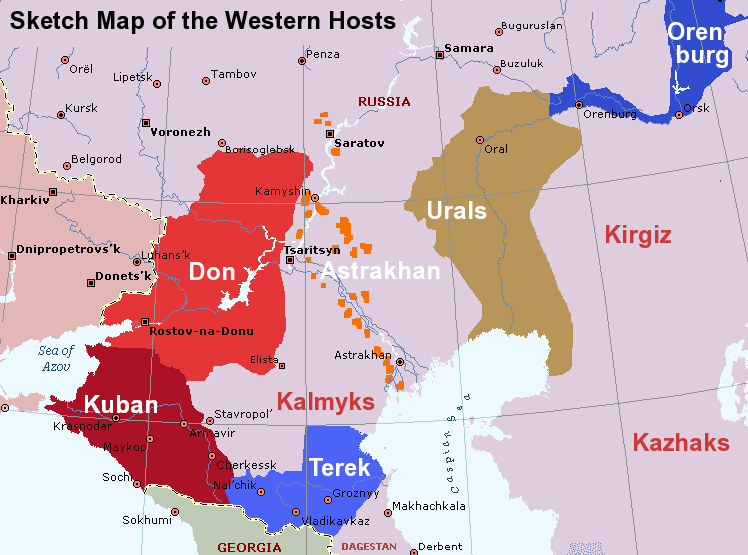
The Kuban Cossack Host
The Kuban Host was formed around the Kuban River, running down the western side of the Russian Caucasus. In 1860 the Black Sea Cossacks and some of the Caucasus Line Cossacks were combined to form the Kuban Host.
As the Black Sea Cossacks were originally from the Ukraine, the Kuban is sometimes regarded as part of the Ukraine.
Uniforms
The Kuban Cossacks wore a Caucasian style uniform, with their distinguishing Host colour being red.
The men were themselves responsible for supplying the uniform, and there was no uniformity of colour. Sergei Mamontov, who served in the horse artillery with the 1st Kuban Cossack Division, describes them "In this regiment the Cossacks wore a red bashlyk. Well, as the Cossacks had to equip themselves, there wasn't a single red shade identical to the others: they went from raspberry to bright red. With their black cloaks and the white snow, it was an unforgettable spectacle lit by the rising sun." (translation from the French version)
A Centre of White Recruitment

The Host area was large, but mostly without major cities. While some Soviet Republics did arise in the area in 1918 – the Black Sea Soviet Republic and the Kuban Soviet Republic, who them merged into the North Caucasian Soviet Republic – there was little natural support for the Reds other than from non-Cossack peasants. Soviet power relied mainly on former soldiers from the Turkish front of WWI, who were in the Kuban in large numbers.
Also claiming power was a new Cossack-based Kuban People's Republic, headed by a rada (council) under Ataman Filimonov. Initially working with the Provisional Government it seceded from Russia immediately after the Bolshevik Revolution. But old rivalries inside the Host made it less effective than it should have been, and the Soviets were able to effectively suppress it.
Into this mix the Volunteer Army made its famous "Ice March" from Rostov to Krasnodar, the centre of Soviet power in the area, and back again. It was just outside Krasnodar that Kornilov merged with a small White Kuban army under Pokrovsky. Soon afterwards the Volunteer Army's "Second Kuban March" swept all major organised Red resistance from the Caucasus. Along the way it collected more local anti-revolutionary groups, such as that of Andrei Shkuro.
Denikin took effective control of the Kuban, although he permitted the appearance of local government, and recruited huge numbers of Kubans into the Volunteer Army. However once the area was cleared of Soviet forces, the Whites moved the bulk of their forces north for the main effort against Russia proper. So unlike the Don, the other major recruiting ground for the Armed Forces of South Russia, the Kuban units were not grouped together and often served far from their homes.
Meanwhile freed of direct threat, the Kuban seethed politically, often directly at odds with their military overlords. Finally, in late 1919, Denikin suppressed the rada entirely.
In 1920, when the Armed Forces of South Russian collapsed, the Soviets made sure to conquer the Kuban quickly so as to cut off such a valuable source of men for the Whites. Although Baron Wrangel sent an expedition from the Crimea under General Ulagay to try and raise the flag in mid 1920, the damage was done and the area could not organise to throw off Soviet power. It did not help that Wrangel had no time for the Kuban separatism (and indiscipline) of the famous Kuban leaders like Shkuro and Pokvosky.